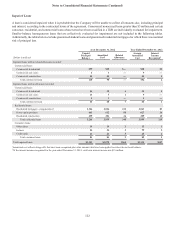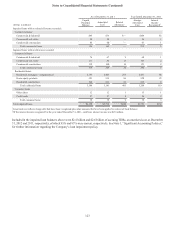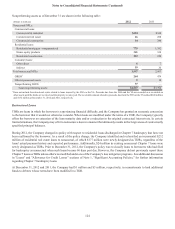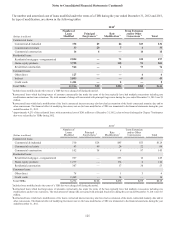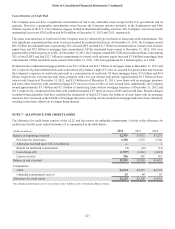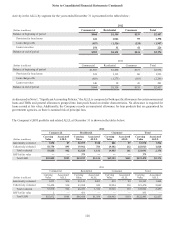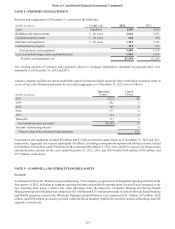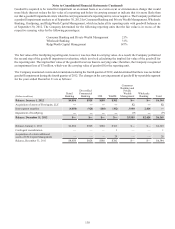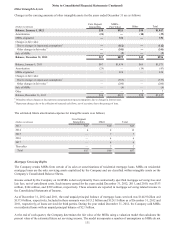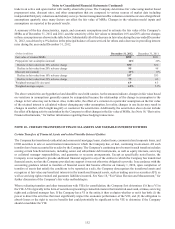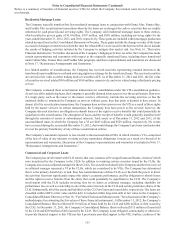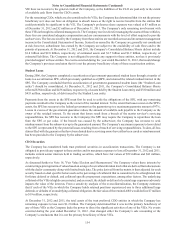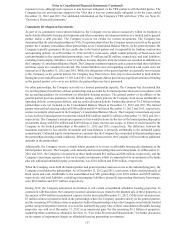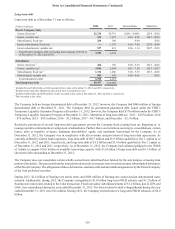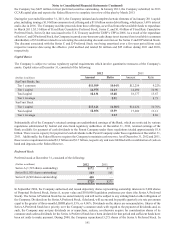SunTrust 2012 Annual Report Download - page 148
Download and view the complete annual report
Please find page 148 of the 2012 SunTrust annual report below. You can navigate through the pages in the report by either clicking on the pages listed below, or by using the keyword search tool below to find specific information within the annual report.
Notes to Consolidated Financial Statements (Continued)
132
trade in an active and open market with readily observable prices. The Company determines fair value using market based
prepayment rates, discount rates, and other assumptions that are compared to various sources of market data including
independent third party valuations and industry surveys. Senior management and the valuation committee review all significant
assumptions quarterly since many factors can affect the fair value of MSRs. Changes in the valuation model inputs and
assumptions are reported in the periods' results.
A summary of the key characteristics, inputs, and economic assumptions used to estimate the fair value of the Company’s
MSRs as of December 31, 2012 and 2011, and the sensitivity of the fair values to immediate 10% and 20% adverse changes
in those assumptions are shown in the table below. Substantially all of the decrease in fair value during the year ended December
31, 2012, was driven by a 9% decline in the principal balance of loans serviced for others and a decrease in prevailing interest
rates during the year ended December 31, 2012.
(Dollars in millions) December 31, 2012 December 31, 2011
Fair value of retained MSRs $899 $921
Prepayment rate assumption (annual) 16% 20%
Decline in fair value from 10% adverse change $50 $52
Decline in fair value from 20% adverse change 95 98
Discount rate (annual) 11% 11%
Decline in fair value from 10% adverse change $37 $33
Decline in fair value from 20% adverse change 70 63
Weighted-average life (in years) 4.9 4.3
Weighted-average coupon 4.8% 5.2%
The above sensitivities are hypothetical and should be used with caution. As the amounts indicate, changes in fair value based
on variations in assumptions generally cannot be extrapolated because the relationship of the change in assumption to the
change in fair value may not be linear. Also, in this table, the effect of a variation in a particular assumption on the fair value
of the retained interest is calculated without changing any other assumption. In reality, changes in one factor may result in
changes in another, which might magnify or counteract the sensitivities. Additionally, the sensitivities above do not include
the effect of hedging activity undertaken by the Company to offset changes in the fair value of MSRs. See Note 16, “Derivative
Financial Instruments,” for further information regarding these hedging transactions.
NOTE 10 - CERTAIN TRANSFERS OF FINANCIAL ASSETS AND VARIABLE INTEREST ENTITIES
Certain Transfers of Financial Assets and related Variable Interest Entities
The Company has transferred residential and commercial mortgage loans, student loans, commercial and corporate loans, and
CDO securities in sale or securitization transactions in which the Company has, or had, continuing involvement. All such
transfers have been accounted for as sales by the Company. The Company’s continuing involvement in such transfers includes
owning certain beneficial interests, including senior and subordinate debt instruments, as well as equity interests, servicing
or collateral manager responsibilities, and guarantee or recourse arrangements. Except as specifically noted herein, the
Company is not required to provide additional financial support to any of the entities to which the Company has transferred
financial assets, nor has the Company provided any support it was not otherwise obligated to provide. In accordance with the
accounting guidance related to transfers of financial assets that became effective on January 1, 2010, upon completion of
transfers of assets that satisfy the conditions to be reported as a sale, the Company derecognizes the transferred assets and
recognizes at fair value any beneficial interests in the transferred financial assets, such as trading assets or securities AFS, as
well as servicing rights retained and guarantee liabilities incurred. See Note 18, “Fair Value Election and Measurement,” for
further discussion of the Company’s fair value methodologies.
When evaluating transfers and other transactions with VIEs for consolidation, the Company first determines if it has a VI in
the VIE. A VI is typically in the form of securities representing retained interests in the transferred assets and, at times, servicing
rights and collateral manager fees. If the Company has a VI in the entity, it then evaluates whether or not it has both (1) the
power to direct the activities that most significantly impact the economic performance of the VIE, and (2) the obligation to
absorb losses or the right to receive benefits that could potentially be significant to the VIE to determine if the Company
should consolidate the VIE.


